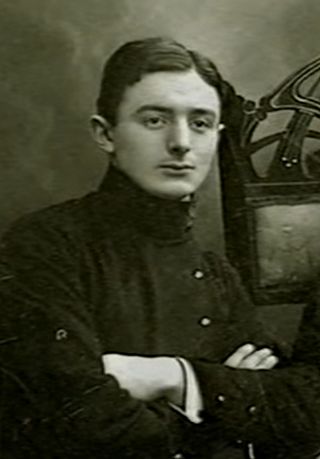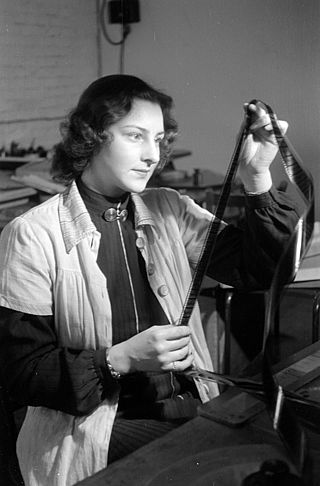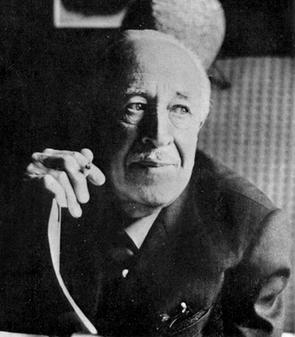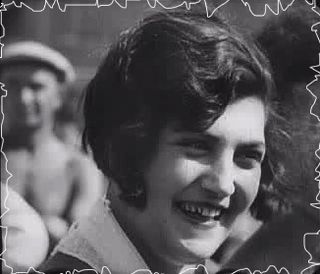
Dziga Vertov was a Soviet pioneer documentary film and newsreel director, as well as a cinema theorist. His filming practices and theories influenced the cinéma vérité style of documentary movie-making and the Dziga Vertov Group, a radical film-making cooperative which was active from 1968 to 1972. He was a member of the Kinoks collective, with Elizaveta Svilova and Mikhail Kaufman.

Film editing is both a creative and a technical part of the post-production process of filmmaking. The term is derived from the traditional process of working with film which increasingly involves the use of digital technology. When putting together some sort of video composition, typically, you would need a collection of shots and footages that vary from one another. The act of adjusting the shots you have already taken, and turning them into something new is known as film editing.

The cinema of the Soviet Union includes films produced by the constituent republics of the Soviet Union reflecting elements of their pre-Soviet culture, language and history, albeit they were all regulated by the central government in Moscow. Most prolific in their republican films, after the Russian Soviet Federative Socialist Republic, were Armenia, Azerbaijan, Georgia, Ukraine, and, to a lesser degree, Lithuania, Belarus and Moldavia. At the same time, the nation's film industry, which was fully nationalized throughout most of the country's history, was guided by philosophies and laws propounded by the monopoly Soviet Communist Party which introduced a new view on the cinema, socialist realism, which was different from the one before or after the existence of the Soviet Union.
Film theory is a set of scholarly approaches within the academic discipline of film or cinema studies that began in the 1920s by questioning the formal essential attributes of motion pictures; and that now provides conceptual frameworks for understanding film's relationship to reality, the other arts, individual viewers, and society at large. Film theory is not to be confused with general film criticism, or film history, though these three disciplines interrelate.

Lev Vladimirovich Kuleshov was a Russian and Soviet filmmaker and film theorist, one of the founders of the world's first film school, the Moscow Film School. He was given the title People's Artist of the RSFSR in 1969. He was intimately involved in development of the style of film making known as Soviet montage, especially its psychological underpinning, including the use of editing and the cut to influence the emotions of audience, a principle known as the Kuleshov effect. He also developed the theory of creative geography, which is the use of the action around a cut to connect otherwise disparate settings into a cohesive narrative.
Marxist film theory is an approach to film theory centered on concepts that make possible a political understanding of the medium.

Sergei Mikhailovich Eisenstein was a Soviet film director, screenwriter, film editor and film theorist. He was a pioneer in the theory and practice of montage. He is noted in particular for his silent films Strike (1925), Battleship Potemkin (1925) and October (1928), as well as the historical epics Alexander Nevsky (1938) and Ivan the Terrible. In its 2012 decennial poll, the magazine Sight & Sound named his Battleship Potemkin the 11th-greatest film of all time.

Man with a Movie Camera is an experimental 1929 Soviet silent documentary film, directed by Dziga Vertov, filmed by his brother Mikhail Kaufman, and edited by Vertov's wife Yelizaveta Svilova. Kaufman also appears as the eponymous Man of the film.

Vsevolod Illarionovich Pudovkin was a Soviet film director, screenwriter and actor who developed influential theories of montage. Pudovkin's masterpieces are often contrasted with those of his contemporary Sergei Eisenstein, but whereas Eisenstein utilized montage to glorify the power of the masses, Pudovkin preferred to concentrate on the courage and resilience of individuals. He was granted the title of People's Artist of the USSR in 1948.

Constructivism is an early twentieth-century art movement founded in 1915 by Vladimir Tatlin and Alexander Rodchenko. Abstract and austere, constructivist art aimed to reflect modern industrial society and urban space. The movement rejected decorative stylization in favour of the industrial assemblage of materials. Constructivists were in favour of art for propaganda and social purposes, and were associated with Soviet socialism, the Bolsheviks and the Russian avant-garde.
The Kuleshov effect is a film editing (montage) effect demonstrated by Russian film-maker Lev Kuleshov in the 1910s and 1920s. It is a mental phenomenon by which viewers derive more meaning from the interaction of two sequential shots than from a single shot in isolation.

Esfir Ilyinichna Shub, also referred to as Esther Il'inichna Shub, was a pioneering Soviet filmmaker and editor in both the mainstream and documentary fields. She is best known for her trilogy of films, Fall of the Romanov Dynasty (1927), The Great Road (1927), and The Russia of Nicholas II and Leo Tolstoy (1928). Shub is credited as the creator of compilation film and is known for her revolutionary approaches to editing and assembling preserved and archived footage.
One of the principal features defining traditional cinema is a fixed and linear narrative structure. In Database Cinema however, the story develops by selecting scenes from a given collection like a computer game in which a player performs certain acts and thereby selects scenes and creating a narrative.
Cinema Petit is Detroit's first international cell phone film festival celebrating a new tool for film and image-making: the cell phone. The festival, run by graduate students from Wayne State University, invites the world to look at and partake in the enormous possibilities that cellular media offers.

Rain is a 1929 Dutch short documentary film directed by Mannus Franken and Joris Ivens. It premiered on 14 December 1929, in the Amsterdam Filmliga's theater, De Uitkijk.

A Sixth Part of the World, sometimes referred to as The Sixth Part of the World, is a 1926 silent film directed by Dziga Vertov and produced by Kultkino. Through the travelogue format, it depicted the multitude of Soviet peoples in remote areas of USSR and detailed the entirety of the wealth of the Soviet land. Focusing on cultural and economic diversity, the film is in fact a call for unification in order to build a "complete socialist society". A mix between newsreel and found footage, Vertov edited sequences filmed by eight teams of kinoks (kinoki) during their trips. According to Vertov, the film anticipates the coming of sound films by using a constant "word-radio-theme" in the intertitles. Thanks to A Sixth Part of the World and his following feature The Eleventh Year (1928), Vertov matures his style in which he will excel in his most famous film Man with a Movie Camera (1929).

Glumov's Diary is a 1923 Soviet silent trick film, which was the first film directed by Sergei Eisenstein. It was conceived as a part of the theatre production of Alexander Ostrovsky’s 1868 comedy Enough Stupidity in Every Wise Man and it marks Eisenstein's transition from theatre stage director to film director.

Enthusiasm: The Symphony of Donbas, also referred to as Donbas Symphony or The Symphony of the Donbas Basin, is a 1931 sound film directed by Soviet filmmaker Dziga Vertov. The film was the director's first sound film and also the first of the Soviet production company Ukrainfilm. The film's score is considered experimental and avant-garde because of its incorporation of factory, industrial, and other machine sounds; human speech plays only a small role in the film's sounds.

Kino-Eye is a film technique developed in Soviet Union by Dziga Vertov. It was also the name of the movement and group that was defined by this technique. Kino-Eye was Vertov's means of capturing what he believed to be "inaccessible to the human eye"; that is, Kino-Eye films would not attempt to imitate how the human eye saw things. Rather, by assembling film fragments and editing them together in a form of montage, Kino-Eye hoped to activate a new type of perception by creating "a new filmic, i.e., media shaped, reality and a message or an illusion of a message - a semantic field." Distinct from narrative entertainment cinema forms or otherwise "acted" films, Kino-Eye sought to capture "life unawares" and edit it together in such a way that it would form a new, previously unseen truth.
Medium essentialism is a philosophical theory stating that each artform has its own distinctive medium, and that the essence of such an artform is dependent on its particular medium. In practice, the theory argues that every artwork should manifest its essential properties, those which no other artform can employ. The theory relies on the presumption that every artform has a unique medium, and is divided into two main interpretations. The ‘limitation’ interpretation of medium essentialism argues that, due to their medium, some artforms should be constrained in their aspirations. The ‘productive’ interpretation reasons that a work's medium determines what content or style will function best, and that practitioners should pursue ventures aligning with the nature of this chosen medium. Clement Greenberg is a prolific medium-essentialist in relation to modernist art, proposing that artists such as Jackson Pollock are successful because they properly exploit elements of their chosen medium, such as a painting's physical flatness. However, medium essentialism was most propagated by film practitioners throughout the twentieth century, as it legitimised cinema as an artform for the first time. Previously, film had been regarded as merely a recorded representation of a written play. It is therefore most discussed today by film theorists, stemming from the work of critics such as André Bazin. Regardless of the interpretation favoured, what constitutes a film's medium, and therefore essential meaning, has been heavily debated, and has prompted the creation of several sub-theories. The theory has been widely discussed among contemporary film theorists and has featured in the Anthology of the Philosophy of Film and Motion Pictures.

















